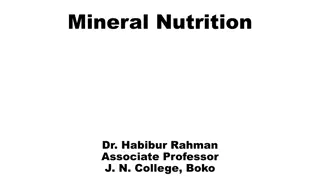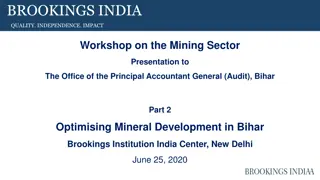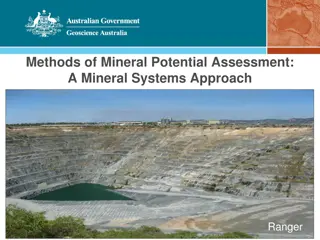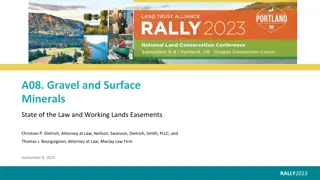Understanding Mineral Reactions in Metamorphism
Mineral reactions play a crucial role in our comprehension of metamorphism, helping to estimate the pressures and temperatures rocks undergo. These reactions can be categorized as continuous or discontinuous, leading to different mineral products. Discontinuous reactions, exemplified by the transformation of Albite into Jadeite and Quartz, are effective geobarometers due to their gentle slope on a P-T graph. On the other hand, continuous reactions involve exchange of elements between minerals, such as Fe-Mg exchange between garnet and pyroxene, serving as reliable geothermometers. Specific examples like the Garnet-clinopyroxene geothermometer highlight the importance of understanding these mineral reactions in geological studies.
Download Presentation

Please find below an Image/Link to download the presentation.
The content on the website is provided AS IS for your information and personal use only. It may not be sold, licensed, or shared on other websites without obtaining consent from the author. Download presentation by click this link. If you encounter any issues during the download, it is possible that the publisher has removed the file from their server.
E N D
Presentation Transcript
Mineral Reactions Mineral reactions are the basis for much of our understanding of metamorphism. Our estimates of pressures and temperatures experienced by rocks during metamorphism are based on metamorphic reactions.
Mineral Reactions There are two basic types of mineral reactions: Continuous Discontinuous
(after Liou, 1987) Discontinuous Reactions Minerals that are the products of reaction are different from the reactants Ex: Albite -> Jadeite + Quartz NaAlSi3O8-> NaAlSi2O6+ SiO2 Jadeite and Quartz are different from Albite Generally make good geobarometers because they have a gentle slope on a P-T graph
(after Liou, 1987) Albite -> Jadeite + Quartz Geobarometer A good geobarometer has a gentle slope
Continuous Reactions Minerals that are the products of reaction are the same as the reactants. Elements are exchanged between different minerals Ex: Fe-Mg exchange between garnet and pyroxene Fe-garnet + Mg-pyroxene -> Mg-garnet + Fe-pyroxene Fe3Al2Si3O12 + 3CaMgSi2O6 -> Mg3Al2Si3O12 + 3CaFeSi2O6 Generally make good geothermometers
Garnet-clinopyroxene geothermometer A good geothermometer has a steep slope after Krogh Ravna 2000























